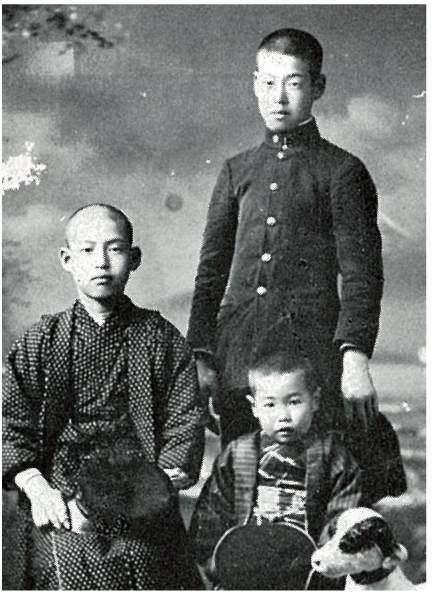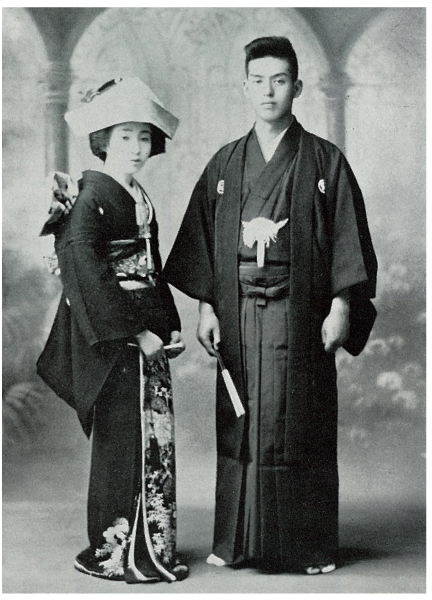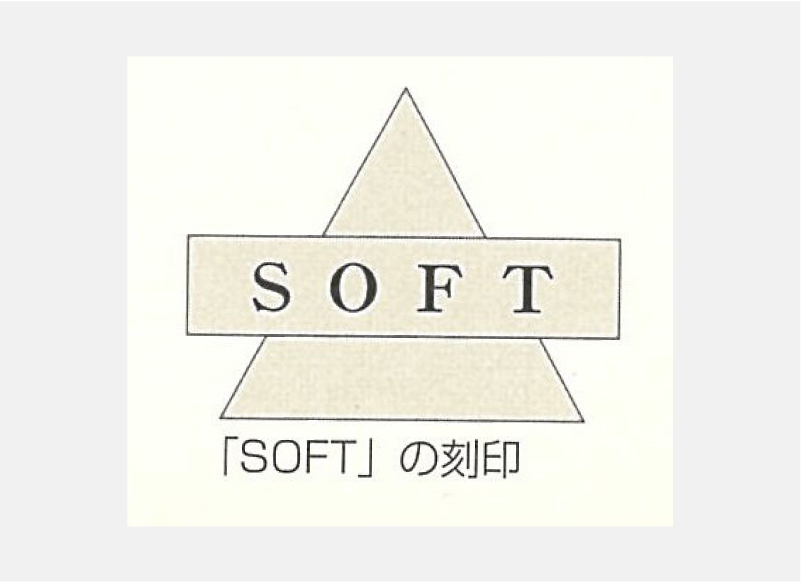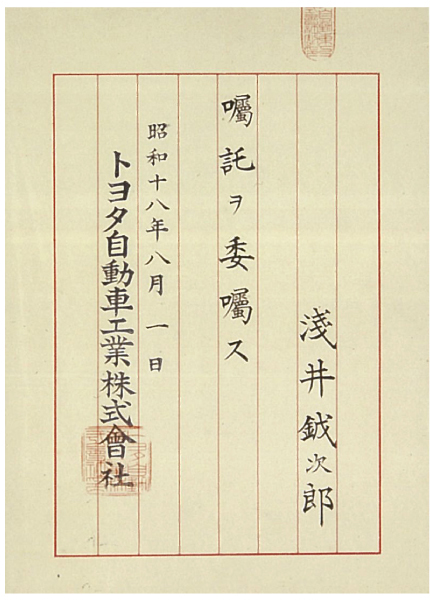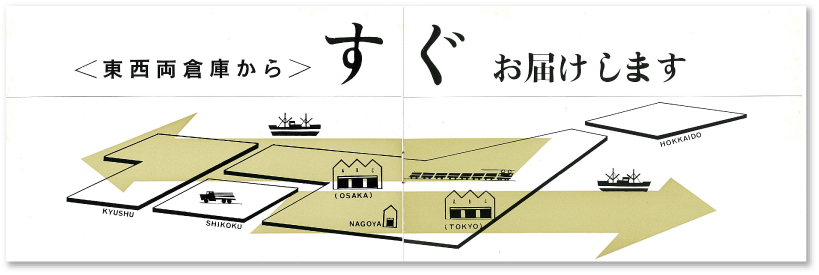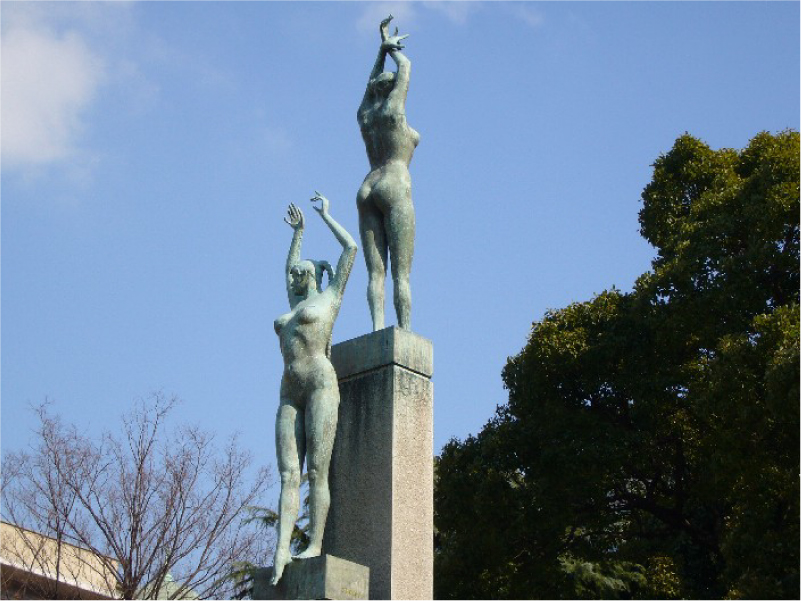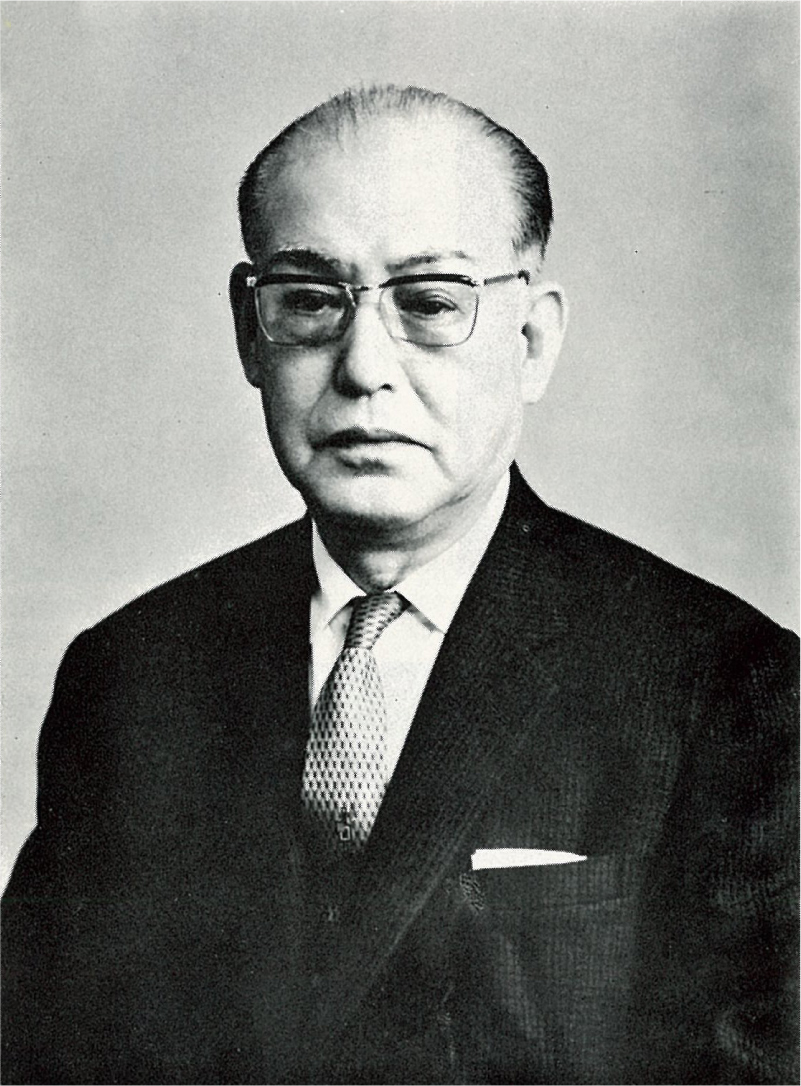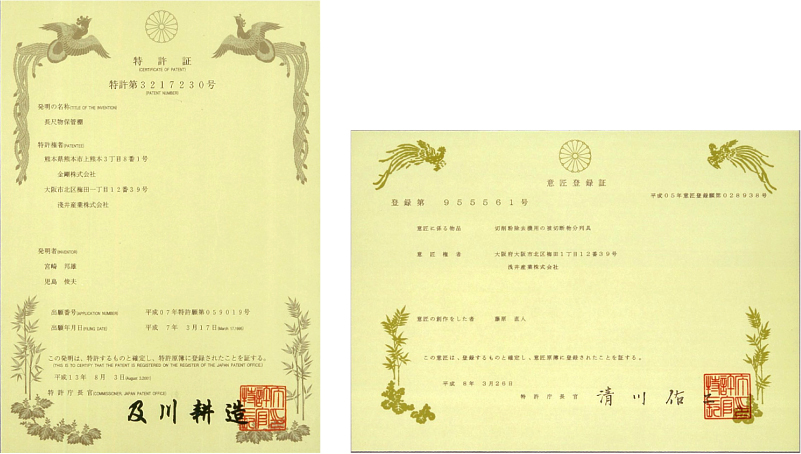OUR COMPANY’S HISTORY
MOVEMENTS WITHIN SOCIETY
From 1917
MOVEMENTS WITHIN SOCIETY-
1917:Events that occurred when Etsujiro Asai was 15 years old
April: Joins Kishida Tetsuten
Etsujiro Asai starts working at a specialized steel wholesaler,and his relationship with Toyota Industries Corporation begins
Etsujiro Asai’s plans to enter his older brother’s company come to naught, and instead finds employment at Kishida Tetsuten with the help of an acquaintance named Setsu Umeda. He is assigned to Nagoya in order to develop new sales channels, and is involved in sales to Toyota-Shiki Shokki, K.K. He is successful in his sales efforts, and a considerable volume of business commenced.
-
1921
In the United States, the Ford Model T exceeds five million units produced.
-
1922:Events that occurred when Etsujiro Asai was 20 years old
Starting a Private Business
The owner of Kishida Tetsuten falls ill, and Etsujiro carries on the company independently.
At the time, ordinary steel was fiercely competitive, and Etsujiro Asai did not have an interest in joining the industry. It was therefore decided to concentrate the company’s efforts exclusively on specialty steel. Relying on Toyota as the primary base, focus was placed on importing standardized materials. Step by step, the company developed specialty steel sales channels.
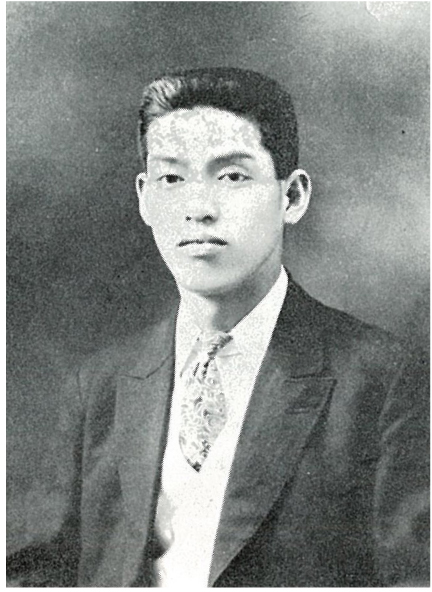
-
1925
The Chrysler Corporation is established in the United States.
-
1926
Toyota Industries Corporation is established.
This company was established in 1924 to manufacture and sell the automatic loom invented and perfected by its founder Sakichi Toyoda.
-
1926:Events that occurred when Etsujiro Asai was 24 years old
April: The “Asai Shoten General Partnership” is established.It is from about this time that trading commences with Kobe Steel, Ltd., one of the company’s major business partners.
The company starts operations as the Asai Shoten General Partnership, with 10,000 yen in capital. The following year the company opened an account at the Itachibori Branch of Sumitomo Bank.
The company sells imported steel products from Germany and from domestic manufacturers including Kobe Steel, Ltd. and NKK. At this time, domestic steel products were almost all non-standardized.
-
1929
The Great Depression begins.
-
September 1933
The Automotive Division of Toyota Industries Corporation is established.
Currently, automotive-related work is applied through the Toyota Industries Corporation articles of incorporation.
-
1933:Events that occurred when Etsujiro Asai was 31 years old
Asai-format steel testing methods are developed.
Designations were given for carbon content, quality assurance was established and rectangular steel was made to have sharp edges. Trading conditions were set in terms of quality and these were implemented as unique material examination methods. The “SOFT” logo was affixed as a metal tag to inbound materials that cleared the quality conditions, and both ends were painted blue. In this manner the company won the trust of its trading partners.
-
November 1935
The Toyota Industries Corporation G1 Model Truck is announced.
-
1935:Events that occurred when Etsujiro Asai was 33 years old
The company is active as the primary wholesaler for NKK.
In addition to its focus on domestic standardized steel sales, the company also conducts business with C. Illies & Co. and other German steel trading firms. It also imports and sells standardized special and intermediary steel products from Germany’s Böchmer Verein and steel manufacturers in the Thyssen Konzern umbrella group.
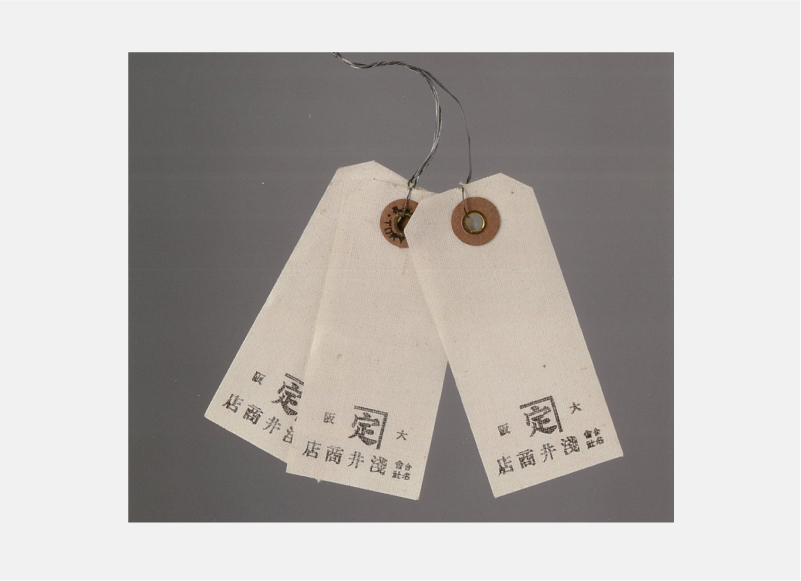
-
August 1937
The Toyota Motor Corporation is established.
In 1937 the automotive division of Toyota Industries was made an independent company and began separate operations. Continuing its relationship with Toyota Industries, the company has delivered steel sheets for frames and high-quality finished steel sheets to the Toyota Motor Corporation since its establishment as a new company.
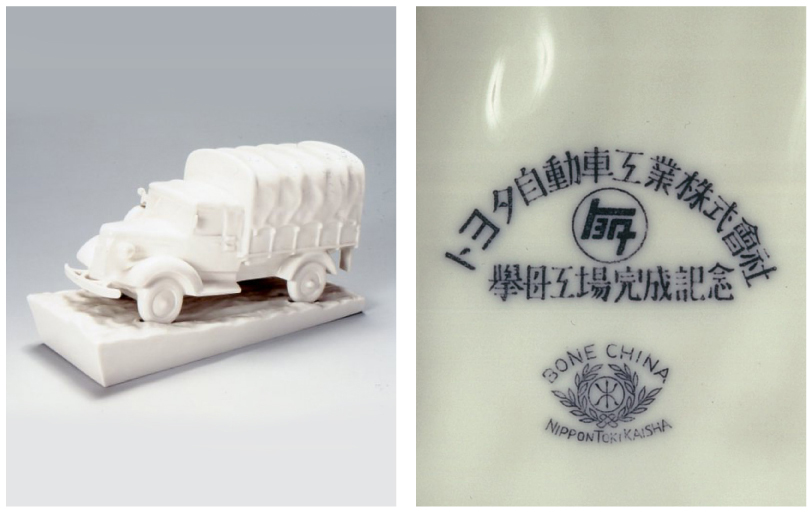
-
1939:Events that occurred when Etsujiro Asai was 37 years old
The company is designated an Intermediate Steel Bar Designated Wholesaler.
The company becomes a member of the regional Intermediate Steel Distribution Associations for Osaka and Nagoya, and is placed under regulation. The company conducts business with trading firms while also importing and selling standardized special and intermediary steel products from Germany’s Böchmer Verein and steel manufacturers in the Thyssen Konzern umbrella group.
-
October 1939
Price control orders are implemented, and the voucher supply system begins.
In December 1939, Intermediate Steel Distribution Associations are established in four areas: Tokyo, Osaka, Nagoya and Yahata. Nationwide, 59 companies are designated as Intermediate Steel Bar Designated Wholesalers.
-
1943:Events that occurred when Etsujiro Asai was 41 years old
Etsujiro Asai receives a commission from Toyota Motor Corporation.
The company receives a commission from the Toyota Motor Corporation, and occupies an important position in supplying materials to the firm. In one famous episode from the time when Toyota’s first factory was being constructed, Etsujiro himself put on work boots and set out to assist with preparing the site.
From 1944
-
December 1944
“Notification Regarding the Unused Commodity Transfer Order”
Seventy-seven tons of ship chain steel is given to the Kinki Ordnance Supervision Department in accordance with the Unused Commodity Transfer Order.
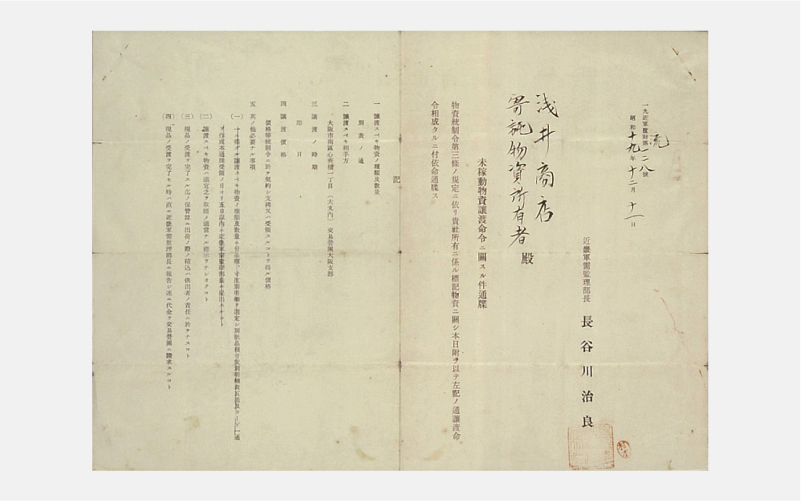
-
1948
Petitions and requests are sent to the Ministry of Commerce and Industry signed jointly by “Blue Steel Association” members.
The company was instrumental in writing the “Petition to the Ministry of Commerce and Industry.” This petition concerned the preferential allocation of steel to loom manufacturers and the designation of Kobe Steel for that purpose. The goal of the petition was to address the allocation system and secure the necessary steel volumes, and was submitted three times. In this way the company contributed to both Kobe Steel and the loom manufacturers.
-
January 1949
The Toyota Motor Corporation faces its greatest post-war managerial crisis.
The company under Etsujiro Asai continued deliveries to the Toyota Motor Corporation, and was resolved to do so even if it meant sacrificing Etsujiro’s private assets. In doing this, the company assisted in the post-war recovery of the automobile industry and the Toyota Motor Corporation. The Toyota Motor Corporation presented the company with a letter of appreciation honoring the company’s efforts. “Since our establishment, your company has consistently contributed to the development and prosperity of the Toyota Motor Corporation. We present this commendation to express our gratitude for your meritorious deeds.”
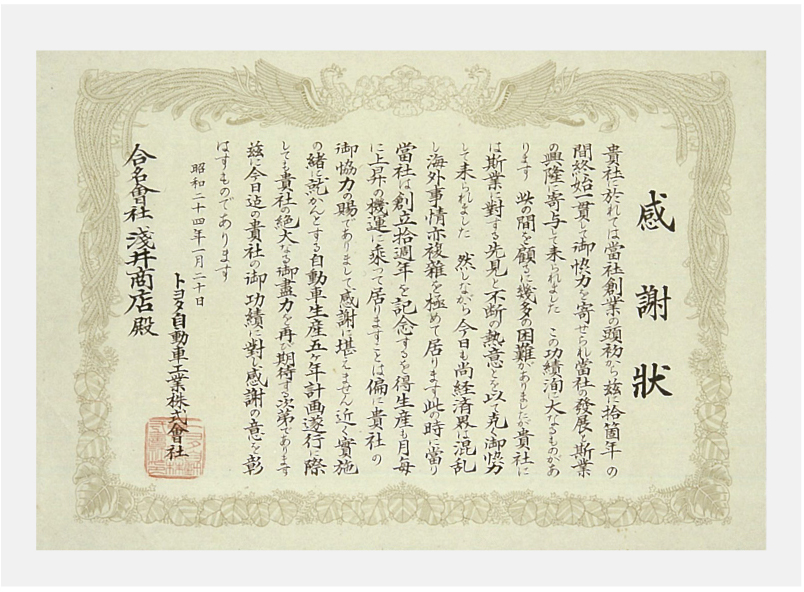
-
1958:Events that occurred when Etsujiro Asai was 56 years old
The company moves toward becoming a “specialized steel department store” in which everything related to specialized steel is always in stock.
Introduction of the Warehouse System
The company purchases 9,614 square meters of land in the Sangenya area of Taisho Ward, Osaka City and constructs a warehouse on the site. The company then begins to continually stock good-quality special steel in its own warehouse. In response to the demands of trading partners, the company uses this warehouse to establish the “just-in-time” method of delivering only what is needed, when it is needed, and in the amount needed to designated locations.
-
1958
The Iwato Period of economic growth begins.
-
1960
Capital is increased to 100 million yen.
Kobe Steel, Ltd. and The Sumitomo Bank, Ltd. become major shareholders.
From 1962
-
1962:Events that occurred when Etsujiro Asai was 60 years old
The company name is changed to Asai Sangyo Co., Ltd.
At the same time the company name was changed, the company moved its main office to the newly-constructed Shin-Hankyu Building located near the main entrance of Osaka Station. The number of employees greatly increased from 20 only a few years earlier to over 100. Asai Sangyo (Asai Industries) was chosen as the company name with hopes as to the kinds of industries the company may enter into in the future.
-
1962
The Tokyo Service Centre is established as a secondary base of operations.
A nationwide service system is constructed.
Through the establishment of the Tokyo Service Centre, a substantial materials supply system is put in place in the Kanto Region as well. The company now is capable of providing only what is needed, when it is needed, and in the amount needed.
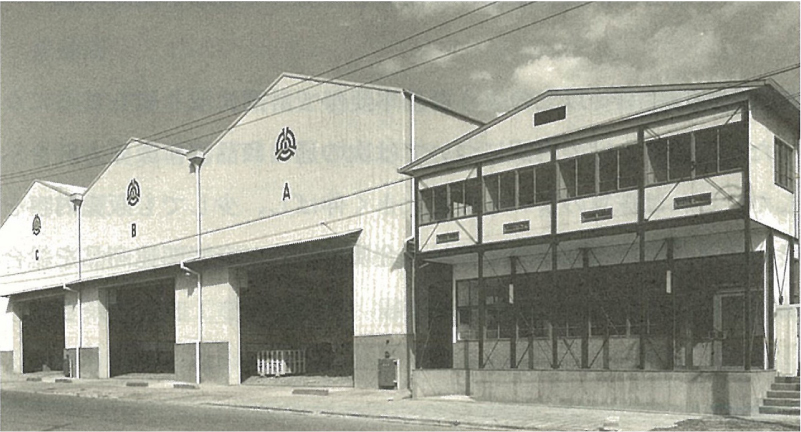
-
1964
The Tokyo Olympics are held.
-
April 1964
Japan formally joins the OECD.
Japan is successful in its transition into an IMF Article 8 country, and enters the free economic system. Japan’s raw steel production reaches 39.79 million tons, overtaking West Germany to become the number three producer behind the United States and the Soviet Union.
-
1964:Events that occurred when Etsujiro Asai was 62 years old
Warehouse business authorization is received from the Ministry of Transport.
The company receives authorization to operate a warehouse business under the Warehousing Business Act, and both the east and west service centres begin to be used widely as sales warehouses.
-
1966:Events that occurred when Etsujiro Asai was 65 years old
Measures are taken to make the company a stable shareholder of the Toyota Motor Corporation.
Through a request from the Toyota Motor Corporation, the company purchases 200,000 shares and becomes a stable stockholder. Asai Sangyo and Toyota Motors thus come to own each other’s shares, further strengthening their relationship as enterprise partners.
-
1967
Toyota announces the 2000GT.
-
1968:Events that occurred when Etsujiro Asai was 66 years old
Etsujiro Asai retires, and his son Mutsunari is appointed president.
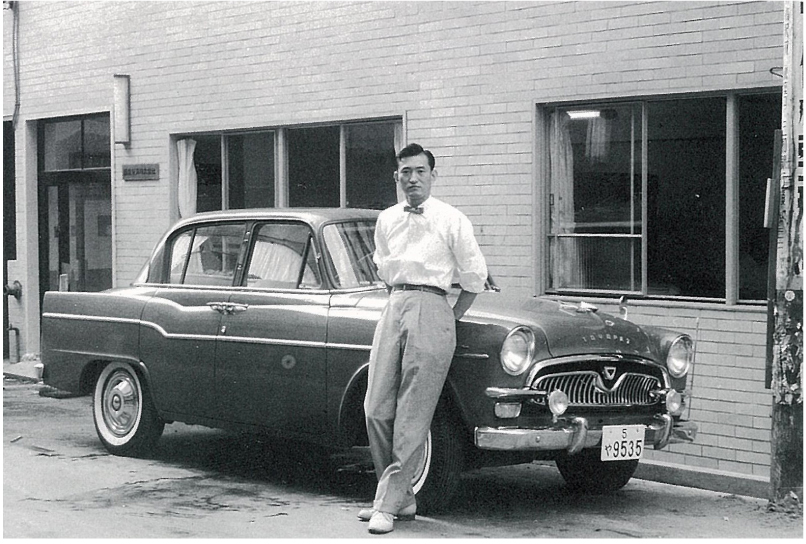
-
1971:Events that occurred when Etsujiro Asai was 69 years old
The Kinuura Service Centre is completed to serve as the third base of operations.
The Kinuura Service Centre logistics base located in Aichi Prefecture is completed. At the time, the facility had four cranes and a stock capacity of 10,000 tons. Thus a system was put into place for quickly delivering “anytime, anywhere, and at the right amount” to Nagoya customers on request.
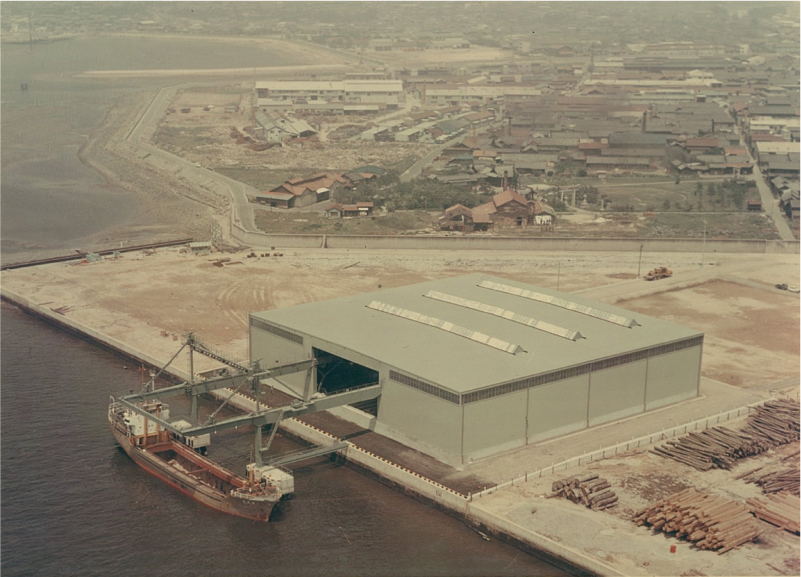
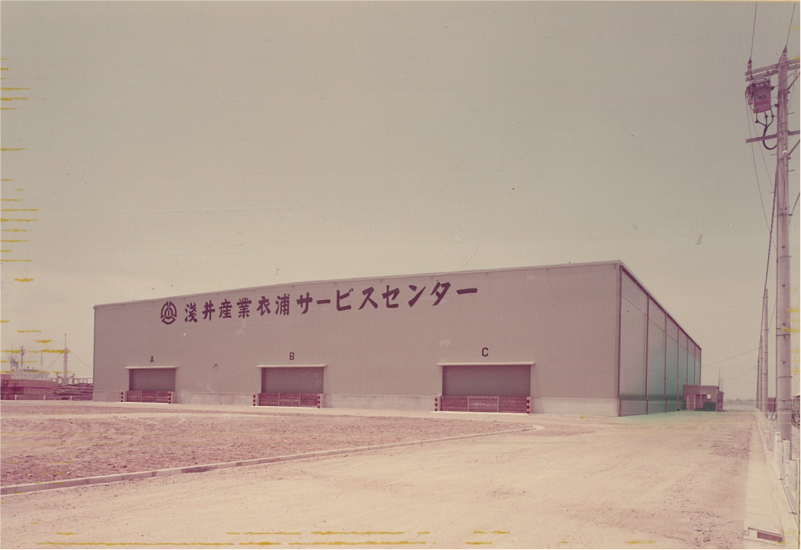
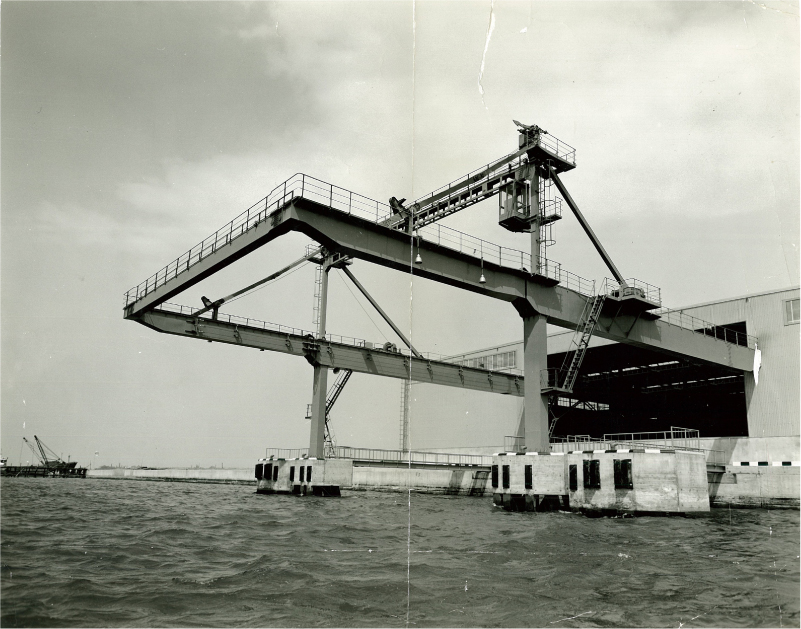
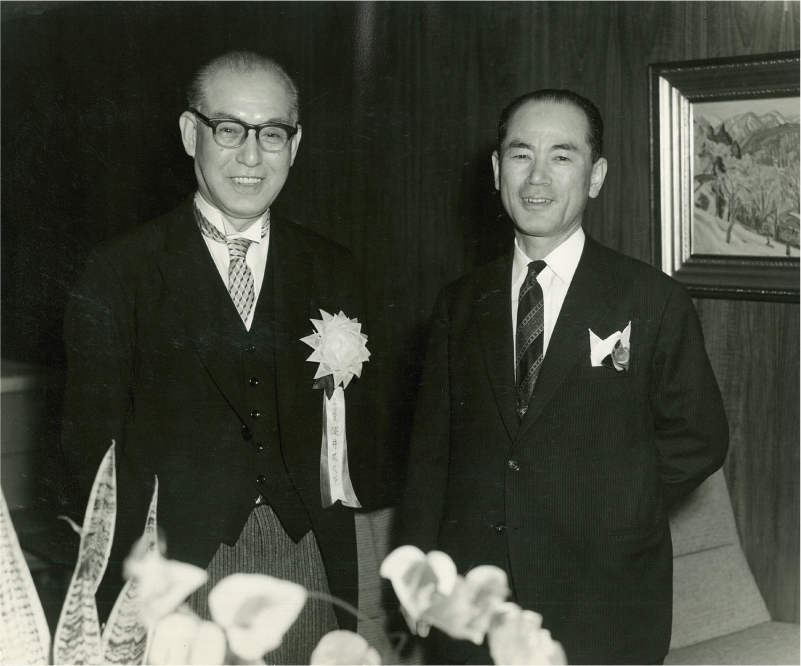
President Sotojima of Kobe Steel Co., Ltd. and President Etsujiro Asai (February 1962)
-
1972
The total number of automobiles manufactured by the Toyota Motor Corporation exceeds 10 million units.
The Toyota Motor Corporation becomes the number one selling automobile importer in the United States for the first time. In this and other ways, the Toyota Motor Corporation begins to build its brand in both name and substance in Japan and abroad.
-
April 1973
Etsujiro Asai donates the “Midori no Sanka” statue to Osaka City’s Nakanoshima Park.
One of the famous works by sculptor Shin Hongo, “Midori no Sanka” is a bronze statue 12 meters in height. Expressing Etsujiro’s desire to see Osaka reborn as a vibrant city, the statue has a design that harmonizes with the greenery of the park. It is a symbol of the people that remains installed at Nakanoshima Park.
From 1975
-
1975:Events that occurred when Etsujiro Asai was 73 years old
The company joins the non-ferrous metals industry and starts its trading business.
Transactions begin with Kobe Steel, Ltd.’s Chofu Manufacturing Plant.
-
1977
The Toyota Motor Corporation adopts the Kanban System for steel deliveries.
Eliminate waste to the greatest degree possible, and then construct an environment in which necessary materials are obtained when needed. In adopting the Kanban System, the objective of making material supply conditions easy to view and visually manage was also achieved. The Kanban System greatly contributes to today’s strict manufacturing system at Toyota.
-
1979:Events that occurred when Etsujiro Asai was 77 years old
Founder Etsujiro Asai passes away.
-
1985
The Development Department is established at the head office.
The company begins selling screws for injecting molding machines. Later, attention began to be focused on cylinders as well. This became the main product of the current Molding Department. The company also found business opportunities in the surface hardening processes of metal molds, cutting tools and other products. Currently this is the main product of the Coating Department.
-
1986
Hekinan Service Centre Co., Ltd. is established.
The company establishes Hekinan Service Centre Co., Ltd. in Hekinan City, Aichi Prefecture. In 2005 the Processing Department is strengthened and spun off as an independent company, which was established as the current Hekinan Processing Centre Co., Ltd.
-
November 1988
Second generation president Mutsunari Asai is awarded the Medal with Blue Ribbon
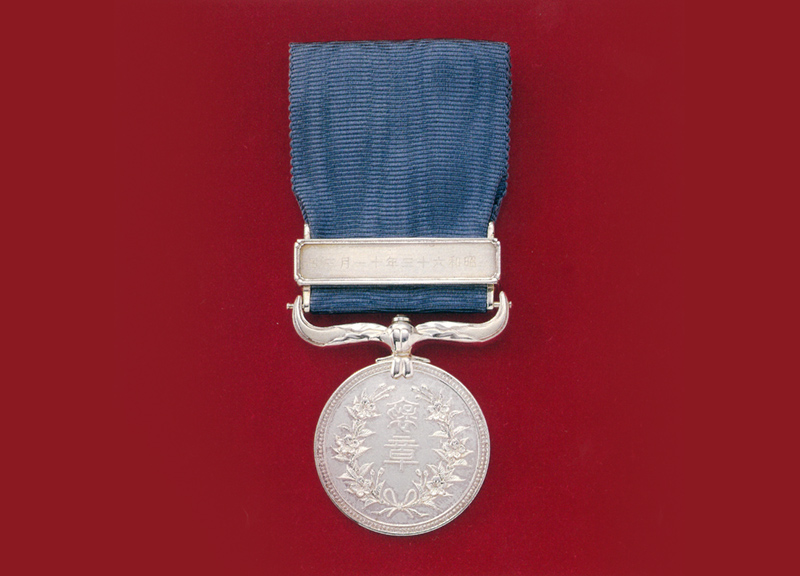
President Asai was awarded the Medal with Blue Ribbon (November 3, 1988)
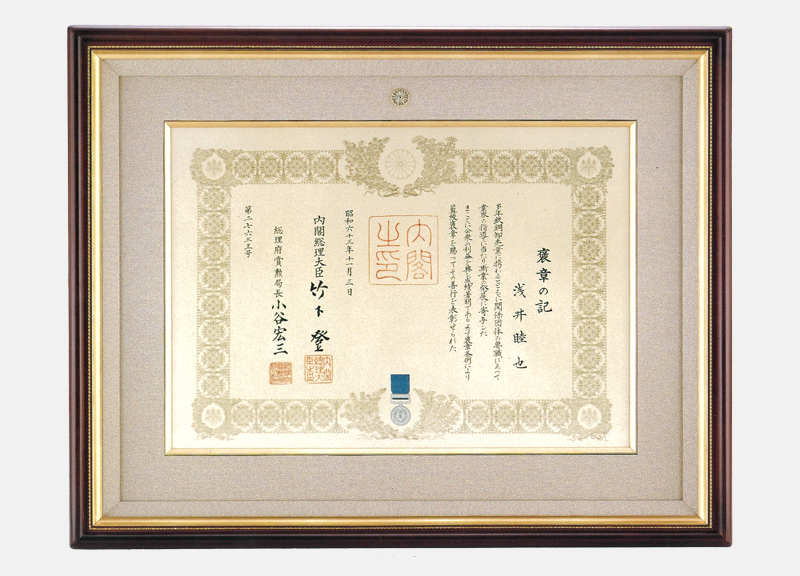
Award Certificate (November 3, 1988)
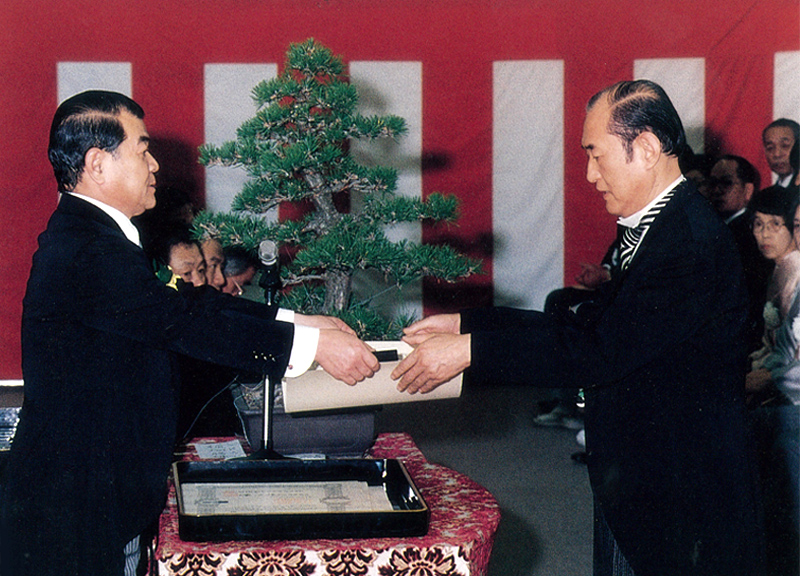
Medal with Blue Ribbon Conferment Ceremony at the Ministry of International Trade and Industry (November 24, 1988)
-
1989
Second generation president Mutsunari Asai passes away.
From 1990
-
1992
Following several increases to capital, the amount of capital increases to its current level of 700 million yen.
-
1993
The first Slide Arm Rack is completed.
Development of In-House Products
1997: Trademark Registration, 2001: Patents AcquiredA simple three-dimensional inventory system capable of storing materials in the limited spaces of factories and warehouses is developed. This system is capable of storing even items for which storage management is difficult such as multiple-type, small-volume steel products and non-ferrous metals. The system was developed jointly with Kongo, Inc.
-
1995
The Great Hanshin earthquake occurs.
The Great Hanshin earthquake occurs, causing damage to Kobe Steel, Ltd., one of the company’s primary suppliers. Product supplies are halted for two and a half months. Alternative materials are brought in from other companies under the name “back-up materials,” and deliveries to transaction partners continue. The company provides Kobe Steel, Ltd. with disaster supplies, and cooperates with them toward recovery.
-
1998
Asai Thai Co., Ltd. is established.
A local corporate branch is established in Bangkok, Thailand. The company begins expanding overseas in order to provide Japanese manufacturers in Southeast Asia with materials under the same conditions as in Japan.
-
1999
Damage from Heavy Rains on June 29th
Kobe Steel, Ltd.’s Chofu Manufacturing Plant is flooded, and the aluminum products warehouse is submerged. The company adjusts delivery dates and performs alternating transfers in the place of Kobe Steel, Ltd., which urgently needs to rebuild its factory.
From 2000
-
2000
Torrential Rain in Tokai Region on September 12th
Economic damage in Japan from these rains exceeds 270 billion yen. The company experiences difficulties supplying its primary users.
-
2002
With the death of Mutsunari’s son Hidehiro Asai (a former executive), the company ceases to be privately owned.
The company was family-managed since its establishment, but in this year that structure ended. Since then, the company has been non-family managed, with the president selected by the employees.
-
2002
Showa Seisakusho Co., Ltd. becomes a subsidiary.
Showa Seisakusho, a company that performed machining and casting services, was purchased and became an Asai Sangyo Group Company. Later, the company name was changed to Asai Showa Co., Ltd.
-
2002
ISO14001 certification is acquired.
The company is certified as an enterprise that reduces environmental burden and conducts environmentally conscious activities. Afterward, in the pursuit of further levels of customer satisfaction, group companies acquire the ISO9001 quality certification from the International Organization for Standardization, and continually work to improve the environment.
-
2011
Tech Ito Co., Ltd. becomes a subsidiary.
Tech Ito, a company that performs forging, heat treatment and machine processing, is acquired through an additional investment and becomes a part of the Asai Sangyo Group. In 1987 a unified processing line was completed, linking all processes from partial forging to machine processing and finishing, including heat treatment. This company would later become Asai Forging Co., Ltd.
-
2011
Great East Japan Earthquake Disaster
Hino Motors, Ltd. visits the main office factory of Asai Showa Co., Ltd. (Shirakawa City, Fukushima Prefecture), part of the Asai Sangyo Group, and goes to considerable lengths in assisting with post-disaster reconstruction.
-
2012
PT. Asai Indonesia is established.
AI is established as an Asian business base.
-
2014
PT. ASP Indonesia is established.
A metal processing manufacturer is established at the Indonesia base of operations. Not limited to importing and exporting materials, the company now can perform processing locally. This increases the range of solutions we can provide our customers.
-
August 2017
Yokohama Technical Center begins operations.
Started original PVD deposition business as a coating manufacturer.
Established Yokohama Technical Center in Kohoku-ku, Yokohama. -
December 2017
Hekinan Processing Center 2nd-Factory begins operation.
Started precision cutting and processing of aluminum extrusions.
-
December 2018
Techno Cut Co., Ltd. becomes a subsidiary.
Techno Cut Co., Ltd. (Sawa-gun, Gunma Prefecture) is a group company which serves as a base for steel distribution and precision cutting in the northern Kanto region.
-
May 2019
Relocated Head Office
Tokyo Head Office is relocated from Konan 2-chome, Minato-ku to Shibaura 4-chome, Minato-ku.
-
2020 -
Pandemic of COVID-19
New coronavirus infections occuring in 2019 spreads worldwide beginning in 2020, and by August 2022, the cumulative number of infected people exceeds 600 million, resulting in a global pandemic.
-
July 2021
The opening of the Tokyo Olympics was postponed for the first time in history by one year.
The Tokyo Olympics, scheduled to open in July 2020, has been postponed for one year due to the global spread of the new coronavirus.
-
April 2022
Celebrating the 100th Anniversary of the Company's Founding.
Asai Sangyo Co., Ltd. celebrates the 100th anniversary of its founding.
-
April 2022
Renewal of the corporate logo of Asai Sangyo Co., Ltd.
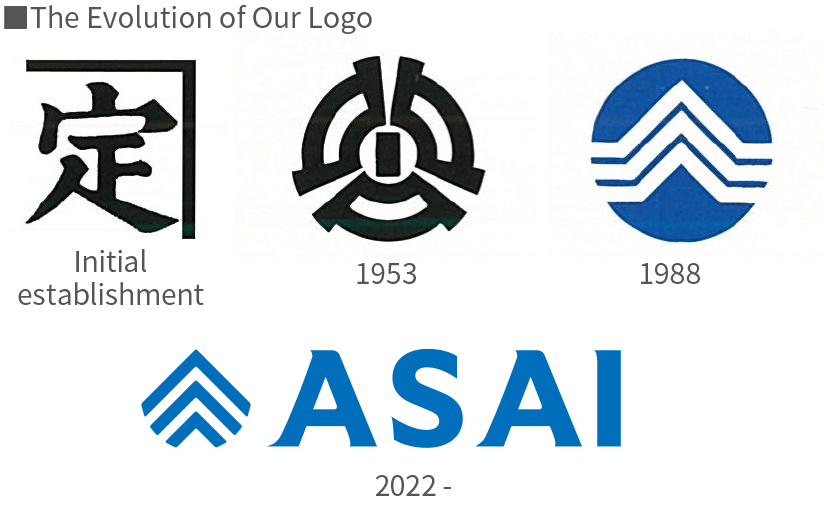
-
September 2022
Shirakawa Bar Precision Co., Ltd. became a subsidiary.
The company engages in lathe processing of steel materials, mainly for construction machinery.
Shirakawa Bar Precision Co., Ltd. is a group company. -
September 2023
The Tado Service Center is completed.
The company establishes a new logistics base in Takahama City, Aichi Prefecture, to enhance its capacity of steel logistics and to serve as a logistics hub for storing electronic components as well as injection molding machine parts.
-
January 1, 2024
Merger of Two Local Indonesian Companies
PT. ASP INDONESIA absorbs and merges with PT. ASAI INDONESIA, establishing a single company structure for Indonesian operations.
-
July 2024
Acquisition of Kyoshin Seiki Co., Ltd. as a subsidiary
Manufacturing of screws and cylinders for injection molding and extrusion machines
Welcoming Kyoshin Seiki Co., Ltd. into the group of companies.

